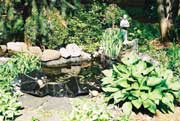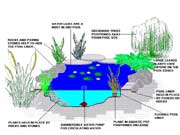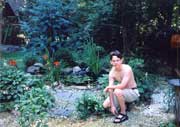|
|
 Pondering a Pond Pondering a Pond
by Janice F. Booth
The joys of a garden pond far exceed the hard digging and regular upkeep that go into creating an oasis-like ecosystemMix a little foolishness with your serious plans,” advised the Roman poet Horace. “It’s lovely to be silly at the right moment.” It seemed the right moment, when my 15-year-old son, Aaron, and I agreed to a splendid plan to begin our summer vacation.
“Let’s make a pond in the back yard,” said he.
“Wouldn’t it be lovely to do something silly and creative together,” thought I.
Exams would soon be over. Long, lazy days and weeks stretched out luxuriously before us. What better way to fill those summer days than to dig a huge hole, fill that hole with rocks and water and introduce a few goldfish and lily pads?
So it was that we dashed off to the farm store one June morning and bought the simplest pond kit we could find. In the kit were a small liner with filtering pump, an attachment for a waterfall or fountain and a tell-all video to get us started. The kit and advice were okay. But, to paraphrase Rod Stewart’s lyrics, If I’d known then what I know now …
If you’re entertaining such an addition yourself — or pondering the wisdom of such an endeavor — my experiences over the past eight years may help. Join me for a deeper look into the quagmires that can await the unwary hobbyist.
 Digging is More Work than Fun Digging is More Work than Fun
Aaron was full of enthusiasm as we laid out the stakes for our pond. But hours of midday digging in packed clay soil left him sweaty and disheartened.
If you’re looking at this as a do-it-yourself project, you probably don’t plan to rent a backhoe or jackhammer. But if you pick a spot that has been undisturbed since your house was built, you may need a pickax to break the earth. Lesson one: Choose a spot where the earth is soft and welcoming.
Our video guide had made it all seem so easy. After laying out the shape, the image faded, then came a smooth, earthen floor ready to receive its liner. No rocks jutted up to puncture the rubber, no lumps gave away spots where digging had been just too tough.
We faded, too, but not to rosy scenes of a tidy pit waiting to be filled with water. Red-faced exhaustion gave way to dwindling interest. A few days after breaking ground, I faced an ugly patch of raw dirt where we’d envisioned shimmering water. I carried on the excavation solo. Smart son remembered he had a commitment to his Scout troop.
Thus, I pass on another hard-won suggestion: Plan the project based on what you are confident you alone can accomplish. If helping hands present themselves, hurrah. If not, your project won’t lose its glow or momentum.
I decided that rather than a two-foot-deep pond, my fish and I would settle for a graded depth from six inches to the deepest area of 34 inches. I rationalized that the shallow edges offered frogs and turtles inviting spots for sun bathing.
 Creating an Ecosystem Creating an Ecosystem
What I hadn’t thought about was that these shallows also served as perfect wading spots for hungry birds, cats and raccoons. Over time, my fish have learned to seek deep water to escape their natural predators.
I’ve learned, too. I’ve sunk a woven-plastic container in the deepest part of the pond to serve as a safe fish hide-away. By scooting inside, the fish are safe from prying paws, claws and beaks.
Yes, you’re getting the picture now; a not-so-large, shallow hole in the yard in which I’ve immersed a red plastic shopping basket. Ah, but it gets better.
As the oh-so-easy guides admonish, you want a setting where your pond basks in sunlight. However, those lovely lotus, water lilies and koi may parboil if they’re exposed to too much of Maryland’s summer sunshine. Think about providing some shade for part of the pond or during part of the day. Depending on how far south you live and how strong your sunlight, you may need to provide overhangs of flat, jutting stone that provide a shady, inviting area for lazy fish to hide. You might even situate your pond near a shady tree.
Remember, you’re working with a tiny ecosystem: balance and mutual dependency. Envision near your pond a stately evergreen in whose shade your fish will gambol. Why a coniferous and not a deciduous tree?
Leaves, my friends. Leave the leaves out of your pond. While a willow’s branches may weep gracefully over the water, those same branches drop thousands of slender leaves into your pond, and thus your filter and pump. A blousy white pine or a majestic Norfolk pine offers shade but keeps most of its needles to itself, near but not in your pond. Our pond is guarded by a graceful Chinese pine, whose drooping branches harbor shy chickadees and gaudy cardinals and cast elegant shadows across the water — but seldom drop and never shed needles.
You’ll want your ecosystem to be beautiful as well as balanced. My plastic safe-house for fish doesn’t seem an aesthetic addition to the ecosystem. Plants help naturalize this big puddle near the friendly tree. To hide any similarly unsightly pond necessities, including pumps and hoses, I recommend two types of plants: those that live in your pond and those that grow near it.
Around the pond, our guiding video suggested lots of big, beautiful stones. Excellent suggestion. I’ve been bringing home trunk-loads of beautiful, flat stones for seven years now, yet there are still areas where my black rubber liner peaks through. That’s where plants come in.
Use inexpensive plants to fill in the gaps between the beautiful stones, which are heavy if you gather them or expensive if you purchase them. Like your tree, the plants shade the pond, shadowing the water to protect your goldfish from high-flying predators and sheltering the tiny birds, butterflies and creatures that find your pond a life-sustaining oasis.
Of course, you’ll splurge on some ornamental grasses, water irises, and showy papyruses planted near the water’s edge. But why not include a few pots filled with geraniums and Shasta daisies? They’ll add color immediately, and you can relocate the flower pots once your permanent plantings begin to flourish.
Near my pond, I’ve had great success planting inexpensive periwinkle. It grows almost anywhere, quickly, and produces purple blossoms early in the spring. The vines will spill over into the water softening those rocky edges.Caution: as you may already have discovered, periwinkle is hardy, and that’s both the good news and the bad. It will take over, given half a chance. Be ruthless in your weeding.
Low, evergreen plants such as periwinkle have another advantage near your pond: They don’t block the view. You’re doing all this work so you can enjoy watching the rippling surface, seeing the fish dart about and glimpsing the wee tadpoles as they grow. Some ornamental grasses grow to five feet or taller. If you plant them, you’ll have to wear your pith helmet and take a machete to view your pond and its occupants.
In the pond itself, you must also consider the size and hardiness of water plants. In addition to the icons of pond décor, lilies and lotus, two types of aquatic plants adorn ponds: floaters and oxygenators. Oxygenating won’t be an issue if you install a bubbler and perhaps a waterfall.
But a word of caution about those floaters: They’ll take over given half a summer. Fragile-looking mosaic plants, ludwigia sedioides and duck weed, will cover the surface of your pond, giving it a gooey green appearance. Water hyacinths and irises are pretty and far less invasive.
 |
| Crafting our little pond remains a favorite family story. Now 23, my son Aaron still watches over his creation, advising me on proper aeration and plantings. |
Keeping up Eden
Digging and lugging eventually end, but maintenance doesn’t stop. That’s the show-stopper for many would-be aqua-gardeners. So before you get into the heavy lifting, it’s a good idea to ask yourself how much work you’re willing to invest keeping alive this tiny Eden and its inhabitants.
My experience suggests that, unless you’re one of those meticulous sorts, you can design your pond to take care of itself most of the year, short of occasional fill-ups on fresh water and periodic pump-filter replacements.
As with all gardens, the high-maintenance tasks make their demands in spring and fall.
One perennial task is mucking out the dead leaves and vegetation that collect in the bottom of the pond. You needn’t be too meticulous; the fish and frogs enjoy a little glop with their pebbled pond floor. However, too much decaying vegetation wreaks havoc with your pond’s pH balance, leading to endless rounds of “dosing” your pond. Dedicate a long-handled fish-net and rubber gloves to your aqua-tools. Old long-handled barbeque utensils work well for getting to the bottom of things.
Two machines — filter and bubbler — also help sustain your pond. Both are handy though not essential for easy maintenance. The bubbler aerates the water and requires virtually no maintenance until its motor dies. While it’s working, the bubbler discourages mosquitoes from depositing their larvae, which will commandeer your pond as their personal nursery.
The filter requires a bit more attention. It contains a pad of porous material that clogs, demanding replacement as the summer rolls along. Come winter, I disconnect and sometimes remove the filter from the pond, returning it in the spring.
The bubbler, however, is a great de-icer, keeping air flowing to the hibernating pond-life and allowing grateful birds to drink from the pond’s air-hole. I check occasionally during the long winter months to be sure the bubbler’s motor is still humming away.
With birds in mind, I also urge the installation of netting over your pond for three or four weeks in early spring and again in autumn. You can pick up berry-bush netting at local farm stores or buy special pond-netting from your nursery.
In the spring, that net protects your recently awakened goldfish and koi from becoming lunch for birds of prey. Hungry herons, migrating hawks and nesting osprey begin their hunt for food in early spring. These avian hunters cruise just above the bare treetops, watching for the next meal. The netting will dissuade a hungry bird from swooping down and plucking your prize koi right out of the pond. Then in the fall, the net limits the volume of leaves that drop into your pond.
If only I had put up my netting earlier last spring, I could have saved three fish.
A pair of osprey nest near our creek, and I’ve come to know their distinctive cry as they hunt. Last April, as I worked at my desk overlooking our pond, I heard the familiar osprey hunting call. Ah, they’ve found lunch to take back to their nest, I thought. Little did I realize that the ospreys’ success had been at the expense of my three plump koi. The next morning when I went out to feed my fish, only one wily koi was to be found, swimming alone in the deepest part of our pond. She remained, safe and well-fed throughout the summer as the vegetation filled in and she filled out. But fate wasn’t to be foresworn. With fall came our hungry osprey. The thinning leaves gave them a clear view down deep into my pond. Poor Lola, as I had come to address my lonely koi, fulfilled her destiny in the great circle of life, and the osprey family dined once more on plump koi.
All this is just to say that netting is worth the trouble. Installation takes finding a means to drape the net over the water, not in it. I use wooden clothespins to secure the ends of the net to higher bows on the evergreen and the tops of some bushes beyond the pond. After a month or so, my net has sagged to the surface of the water, but by then it’s usually time to roll it up and store it in a large bucket until next season. You may be adept enough to make a tent of PVC pipe; easily taken apart, the frame stores compactly during the off-seasons. Or you may devise an even more elegant solution. bushes beyond the pond. After a month or so, my net has sagged to the surface of the water, but by then it’s usually time to roll it up and store it in a large bucket until next season. You may be adept enough to make a tent of PVC pipe; easily taken apart, the frame stores compactly during the off-seasons. Or you may devise an even more elegant solution.
Pondside at Last
By now, you may be wondering why anyone ever entertained the idea of installing a pond. Don’t give up. The joys of a garden pond far exceed the inconveniences, as do the stories your own pond will give you. Crafting our little pond remains one of our favorite family stories. We giggle as we recall mother and son sweating with pick ax and shovels under the blazing sun. At 23, Aaron still watches over his creation, advising me on proper aeration and plantings. Together, we are humbled by the beauty of our simple pond and charmed by the community of birds, squirrels, cats and frogs that share the pond with us.
About the Author
Partner in a small business, adjunct professor, writer, traveler, dabbler in paint and soil, wife, mother and retired public school teacher — Jan Booth has always been a humble student of the garden. This is her first story for Bay Weekly.
|

 bushes beyond the pond. After a month or so, my net has sagged to the surface of the water, but by then it’s usually time to roll it up and store it in a large bucket until next season. You may be adept enough to make a tent of PVC pipe; easily taken apart, the frame stores compactly during the off-seasons. Or you may devise an even more elegant solution.
bushes beyond the pond. After a month or so, my net has sagged to the surface of the water, but by then it’s usually time to roll it up and store it in a large bucket until next season. You may be adept enough to make a tent of PVC pipe; easily taken apart, the frame stores compactly during the off-seasons. Or you may devise an even more elegant solution.
 Pondering a Pond
Pondering a Pond Digging is More Work than Fun
Digging is More Work than Fun Creating an Ecosystem
Creating an Ecosystem